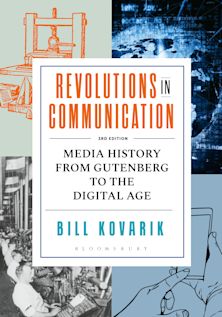- Home
- ACADEMIC
- Film & Media
- Media History
- Revolutions in Communication
Revolutions in Communication
Media History from Gutenberg to the Digital Age
- Textbook
Revolutions in Communication
Media History from Gutenberg to the Digital Age
- Textbook
Inspection copy added to basket
Choose your preferred format. If you would prefer an ebook and it is not displayed below, please visit our inspection copies page.
Please note ebook inspection copies are fulfilled by VitalSource™.
Buy from Bloomsbury eTextBooks
You are now leaving the Bloomsbury Publishing website. Your eBook purchase will be with our partner https://www.vitalsource.com.
Your credit card statement will show this purchase originating from VitalSource Technologies. They will also provide any technical assistance you might require.
You must sign in to add this item to your wishlist. Please sign in or create an account
Description
Revolutions in Communication offers a new approach to media history, presenting an encyclopedic look at the way technological change has linked social and ideological communities. Using key figures in history to benchmark the chronology of technical innovation, Kovarik's exhaustive scholarship narrates the story of revolutions in printing, electronic communication and digital information, while drawing parallels between the past and present.
Updated to reflect new research that has surfaced these past few years, Revolutions in Communication continues to provide students and teachers with the most readable history of communications, while including enough international perspective to get the most accurate sense of the field. The supplemental reading materials on the companion website include slideshows, podcasts and video demonstration plans in order to facilitate further reading. www.revolutionsincommunication.com
Table of Contents
Introduction to Revolutions in Communication
Section I - The Printing Revolution: An Introduction
Chapter 1: The Printing Revolution: 1455 to 1814
Chapter 2: The Commercial and Industrial Media Revolution: 1814 to 1900
Chapter 3: Print Media in the 20th and 21st Centuries
Section II - The Visual Revolution
Chapter 4: Photography: Giving Vision to History
Chapter 5: Motion Pictures, Dream Factories and Popcorn Palaces
Chapter 6: Advertising, Public Relations and the Crafted Image
Section III - Electronic Revolution: From 'National Neighborhoods' to the Global Village
Chapter 7: The First Electronic Revolution: Telegraph and Telephone
Chapter 8: Radio: The Electronic Hearth
Chapter 9: Television: A New Window on the World
Section IV - The Digital Revolution: Traditional Media and the Curves in the Road
Chapter 10: The Advent of Computers
Chapter 11: Networks
Chapter 12: Global Digital Media Culture
Bibliography
Index
Product details

| Published | 19 Nov 2015 |
|---|---|
| Format | Ebook (PDF) |
| Edition | 2nd |
| Extent | 400 |
| ISBN | 9781628924800 |
| Imprint | Bloomsbury Academic |
| Illustrations | 150 bw illus |
| Publisher | Bloomsbury Publishing |
About the contributors
Reviews
-
A stunning work of research, it conveys intellectual excitement and stimulates creative thinking about the social construction of communication.
Maurine H. Beasley, Professor Emerita of Journalism, Philip Merrill College of Journalism, University of Maryland College Park, USA
-
I could almost imagine myself standing next to William Caxton as the newly inked printed pages of the Canterbury Tales began to accumulate on the table next to his printing machine. Bill Kovarik's latest work on the history of the media has brought together under one academic roof the role of technology and how it has shaped our way of life and our world. He deserves full credit for the way his words take on both colour and a sense of adventure. This work belongs on the book shelves of any university or college program in which the study of technology and its companion media has a central focus. Let it be said that Kovarik's readers will never suffer a dull moment in this beautifully tailored work as he walks through some of the most important history of the age from the iPad to the cell phone to the Internet.
David R. Spencer, Professor of Information and Media Studies, University of Western Ontario, Canada
-
Kovarik has the most complete understanding of media technology among journalism historians working today. It is a very interesting and useful work.
Mark Neuzil, Professor of Communication and Journalism, University of St. Thomas
-
As an historian of both technology and the media, Bill Kovarik has made a unique contribution to our understanding of communication history. He explains how the print, visual, electronic, and digital technological revolutions have shaped communication. Equally important, he shows that that new technologies have been invented to overcome the limitations of existing media. This is fascinating reading, both for communication scholars and historians.
James E. Grunig, Professor Emeritus of Communication, University of Maryland, USA
-
A clear benefit of the second edition Revolutions in Communication is its focus on recent technological revolutions in media. As I tell my undergraduate media history students on the first day, the one constant in professional journalism and related fields is technological change. Seeing how people in the past have dealt with change, as outlined in Kovarik's book, offers a way of keeping history relevant while grappling with shifts in media technologies.
Jane Marcellus, Professor of Journalism, Middle Tennessee State University, USA
-
A solid and very accessible textbook. The first edition of Revolutions in Communication does an excellent job in introducing a wide range of topics, and while the second edition maintains that, it further introduces a level of international orientation that is extremely important and welcome.
Glenn Ruhl, Professor in Communication Studies, Mount Royal University, Canada




































